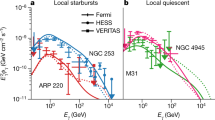Abstract
MANY measurements of the diffuse X-ray and γ-ray background1–4 indicate that it consists of an inverse power law spectrum with index ∼2.0. Spectral features or excesses are reported in the vicinity of ∼40 keV and ∼1 MeV. When plotted on linear–linear paper the 1 MeV excess is seen to consist of a pronounced peak in the 0.5 to 2.0 MeV region with a feeble tail extending on to higher energy (Fig. 1). In this paper a simple explanation is presented for the 1 MeV peak in light of new experimental and theoretical advances made in the past year. No explanation is presented for the higher energy excess and it is presumed to come from other mechanisms. I hypothesise that the peak arises from the astrophysical production of deuterium by the two body recombination process (p+n→D+2.2 MeV γ ray) in an environment transparent to the emitted γ rays. The hypothesis is shown to lead unambiguously to two remarkable numerical results: a calculation of the terrestrial n(D)/n(H) ratio; and a prediction of QSO cutoffs at z∼3.
Similar content being viewed by others
References
Peterson, L. E., Pelling, R. M., and Matteson, J. L., Space Sci. Rev., 13, 320 (1972).
Pal, Y., Proc. IAU Symp., 55 (Madrid, in the press).
Stecker, F. W., Nature, 241, 74 (1973).
Trombka, J. I., Metzger, A. E., Arnold, J. R., Matteson, J. L., Reedy, R. C., and Peterson, L. E., Astrophys. J., 181, 737 (1973).
Clayton, D. D., and Silk, J., Astrophys. J. Lett., 158, L43 (1969).
Jefferts, K. B., Penzias, A. A., and Wilson, R. W., Astrophys. J. Lett., 179, L57 (1973).
Spitzer, L., Drake, J. F., Jenkins, E. B., Morton, D. C., Rogerson, J. B., and York, D. G., Astrophys. J. Lett., 181, L116 (1973).
Hoyle, F., and Fowler, A., Nature, 241, 384 (1973).
Colgate, S. A., Astrophys. J. Lett., 181, L53 (1973).
Chupp, E. L., Forrest, D. J., Higbie, P. R., Suri, A. N., Tsai, C., and Dunphy, P. P., Nature, 241, 333 (1973).
Ramaty, R., and Lingenfelter, R. E., in High Energy Phenomena on the Sun (edit. by Ramaty, R., and Stone, R. G.), 301 (Goddard Space Flight Center, Greenbelt, Maryland, 1973).
Author information
Authors and Affiliations
Rights and permissions
About this article
Cite this article
LEVENTHAL, M. Deuterium Formation Hypothesis for the Diffuse Gamma-ray Excess at 1 MeV. Nature 246, 136–138 (1973). https://doi.org/10.1038/246136a0
Received:
Issue Date:
DOI: https://doi.org/10.1038/246136a0
- Springer Nature Limited





